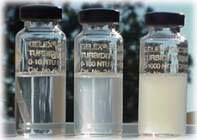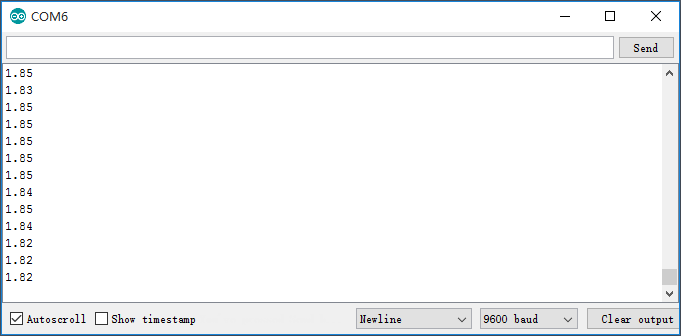What is Turbidity and How to measure Turbidity in water with the Arduino?

Do you know what is turbidity? Do you know that turbidity is in your water too? What is turbidity in water?
Curious what the answer is to all these questions? Continue reading as today guide will cover:
- What is Turbidity?
- Is turbidity in water dangerous?
- How to measure turbidity in water with the Arduino?
What is Turbidity
Turbidity is the cloudiness or haziness of a fluid caused by large numbers of individual particles that are invisible to the naked eye, like smoke in the air but turbidity is in a fluid. It is the measurement of relative clarity of a liquid and a key test of water quality.
It is an optical characteristic of water that makes water cloudy or opaque. It measures the amount of light that is scattered by the material in the water when a light is shined through the liquid where the higher the intensity of scattered light, the higher the turbidity. Turbidity is measured by shining a light through the water and is reported in nephelometric turbidity units (NTU).

What material causes liquid to be turbid?
The material that causes liquid to be turbid ranges from clay, silt, very tiny inorganic and organic matter, growth of phytoplankton, algae, dissolved coloured organic compounds and other microscopic organisms.
How does these particles get into the water?
These materials can get into liquids in various ways from human activities (eg. construction, mining), soil erosion, waste discharge to also algae growth.
For example, in clear weather, rivers are clear where turbidities are low. But after a rainstorm, particles from the surrounding land are washed into the river due to the rain which gives water a muddy brown colour where turbidities level are high.
Is Turbidity in Water Dangerous?
At low levels, turbidity is harmless. But at high concentrations, turbidity can cause various problems to human health and nature.
Turbidity Effect on Water Bodies
When water bodies in nature such as lakes, rivers, and reservoirs has a high level of turbidity, it can affect light penetration and ecological productivity as light is unable to reach lower depth which can inhibit growth of submerged aquatic plants which can affect other species that are dependent on plants too such as fish and shellfish.
The suspended particles also absorb heat from the sunlight which makes turbid water becomes warmer and reduce the concentration of oxygen in the water as oxygen dissolves better in colder water. Certain living organisms in water bodies cannot survive in warmer waters as well.
With a high turbidity level, it may also affect the ability of fish gills to absorb dissolved oxygen who are living inside the water bodies. Particles in the water also provide attachment places for other pollutants such as metals and bacteria.
However, for certain areas such as mangrove plantations, high turbidity is essential to support certain species. High turbidity can actually protect fish prey from predators which are essential for proper ecosystem health.
Turbidity Effect on Human Health
Firstly, high turbidity in drinking water is aesthetically unappealing due to the cloudiness in water. It may also represent a health concern as the risk is high for people to develop gastrointestinal diseases as turbidity can provide a good breeding location for pathogens.
If not removed, the causes of high turbidity promote regrowth of pathogens in drinking water which can lead to waterborne diseases.
In addition, turbidity also helps the attachment of heavy metals and many other toxic organic compounds and pesticides which is definitely not good for human health.
How much turbidity should be in your drinking water?
So now you know that a high level of turbidity in your drinking water is harmful, what is the maximum allowed turbidity in drinking water?
Well, the WHO (World Health Organization) states that the turbidity of your drinking water shouldn’t be more than 5 NTU and should be below 1 NTU.
How to measure turbidity in water with the Arduino?
There are many ways to measure turbidity in your water but they are often quite costly and turbidity meters can reach up to $100. So why not create your own turbidity meter with the Arduino and our Grove turbidity sensor at under $30!
What do you need?
- Arduino Uno Rev3 / Seeeduino V4.2
- Base Shield – Optional, To make connections simpler
- Grove – Turbidity Sensor (Meter) for Arduino V1.0
Step by Step Instructions on how to make a Turbidity Meter with the Arduino
Step 1: Connect all the hardware
- Switch the turbidity sensor to A
- Connect Grove – Turbidity Sensor to port A0 of Grove-Base Shield.
- If you do not have a Grove Base shield, you can directly connect the Grove – Turbidity Sensor to Seeeduino as per shown below:
| Seeeduino V4.2 | Grove – Turbidity Sensor |
| 5V | Red |
| GND | Black |
| Not Connected | White |
| A0 | Yellow |
- Plug Grove – Base Shield into Seeeduino.
- Connect Seeeduino to PC via a USB cable.
- Your connection should look something like this currently:

Step 2: Copy and upload code
- Open Arduino IDE and create a new file. Afterward, copy the following code into the new file:
void setup() {
Serial.begin(9600); //Baud rate: 9600
}
void loop() {
int sensorValue = analogRead(A0);// read the input on analog pin 0:
float voltage = sensorValue * (5.0 / 1024.0); // Convert the analog reading (which goes from 0 - 1023) to a voltage (0 - 5V):
Serial.println(voltage); // print out the value you read:
delay(500);
}- Upload the code. If you do not know how to upload the code, you can check out our guide on how to upload code
Step 3: Change Settings
- Open the Serial Monitor of Arduino IDE by clicking Tool-> Serial Monitor or tap the Ctrl+Shift+M key at the same time.
- Set the baud rate to 9600.

Step 4: Monitor Results
- Now everything is set up, place the sensor into any water source and monitor the results.

Summary
Now you know what is turbidity, its harmful effects and how to create your own turbidity meter with the Arduino, you can now measure the turbidity in your water! Here are some uses and applications of the turbidity meter:
- Measure the water pollution degree of washing machines such as dishwashers to determine the optimal washing time and rinsing times.
- Industrial site control.
- Environmental sewage collection.
Other than a turbidity sensor, we also offer other water-related sensors like our TDS (Total Dissolved Solids) sensor to measure the amount of inorganic and organic minerals in your water. Check out our guide on TDS in water – What is TDS and How to measure TDS in water with Arduino to find out more!
We also offer a water level sensor for your water sensing needs! Want to monitor a sump pit to control pump activation? Or do you want to detect rainfall, leakage, etc? With a water level sensor, you can do all the above and also many other projects. Interested? Check out our water level sensor here!